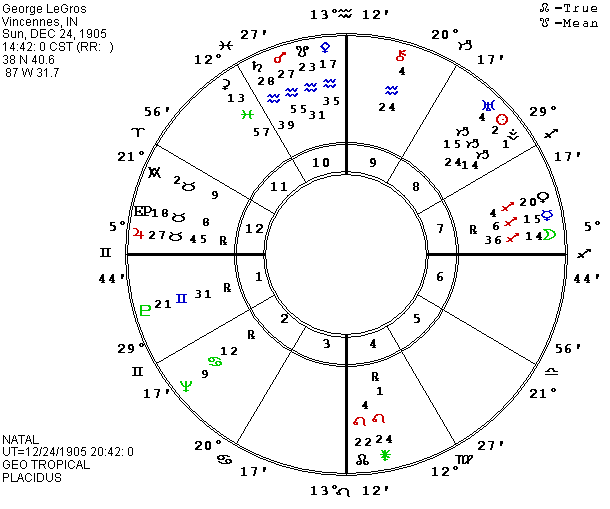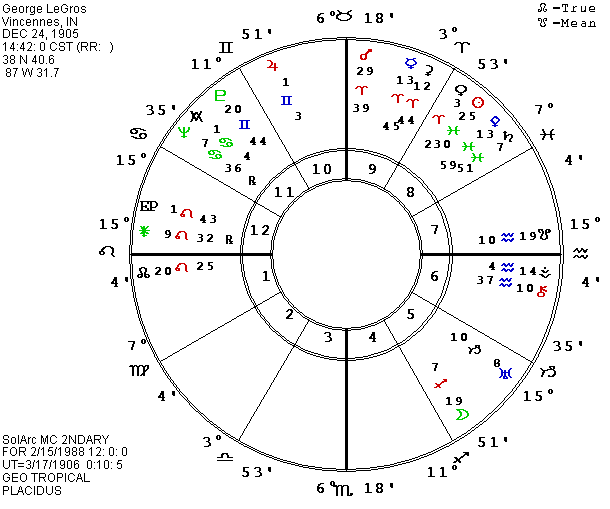George Cardinal Le Gros
Zip Dobyns
The data for Le Gros’ birth and death came from one of the students at our recent seminar in Montana. He was a famous astrologer and Theosophist, a counselor, teacher, and writer. I never met him, though we corresponded briefly many years ago.

We can see from Le Gros’ chart that his career matched his talents. His air and fire emphasis shows mental versatility and potential brilliance. With Gemini rising and Mercury in Sagittarius, he could probably out-talk almost anyone, knowing a little about everything and possessing a keen sense of humor. But he also had the potential for psychic ability with his air-water mixtures: Pluto, a water planet, is in the air sign of Gemini and Mercury, an air planet, is conjunct the Moon, a water factor. The third water planet, Neptune, is in a water sign and it moved by progression into a long-term opposition to Uranus, an air planet which often indicates the capacity for expanded consciousness. The sensitive water side of the nature was further strengthened by activity in all the water houses. The intellectual, verbal air side of the nature was strengthened by the stellium in Aquarius: Chiron in the ninth for the life-long search for truth, Pallas in the tenth for the pursuit of social justice for humanity and a counseling career, the south lunar node also there for the desire to be self-employed and the urge to teach, Mars and Saturn also in the tenth repeating the desire to be in control of his own career.
The practical side of Le Gros’ nature was also amply shown by the strong tenth house with Saturn in its own house, by the two auxiliary Ascendants and Jupiter in Taurus, and by the Capricorn group in the eighth house, especially since it included Vesta, our super-Virgo asteroid. The tight Vesta-Sun conjunction is especially important with Uranus adding to its intensity. I have mentioned in the past that some of our most talented healers were born with Vesta on the Sun. They have included physical, psychological, psychic and spiritual healers, but they shared the devotion to healing, the “tunnel vision” that can be found with Vesta. The eighth house placement added the potential for still more depth, the urge to seek answers behind the surface, the attraction to occultism, while Uranus encouraged the fascination with astrology. Le Gros was certainly suited to his choice of vocation and he came to it when it was little known, either ignored or disdained by most of society.
Le Gros’ personal idealism is shown by the placement of Mercury, the ruler of the Ascendant, in Sagittarius. It is repeated by Jupiter widely conjunct the Ascendant from the twelfth house. I don’t know whether Le Gros knew about the use of locality charts calculated for one’s place of residence, but with or without that conscious knowledge, he moved to a town which put natal Jupiter exactly on the Ascendant.
I do not know whether Le Gros had children, but suspect that he did not. Ceres is in Pisces in the eleventh house, a common placement for people who work with the children of others instead of having their own. Mercury and Venus, rulers of the fifth house, are both in the seventh house of partnership and Juno, natural key to mate, is in the fourth house. We procreate with the fifth house but care for them with the fourth, and Le Gros’ chart suggests that his wife substituted for children. He was married to a dancer, fitting the fire signs connected to marriage. It takes immense energy to dance professionally. Vesta and Capricorn in the eighth house also suggest a career-minded wife who might have been too busy to stop for children. The Leo-Aquarius nodes across the fourth-tenth houses also show that Le Gros himself felt pulled between home and family versus career and independence. The idealism of fifth house rulers in Sagittarius and Ceres in Pisces suggest someone who would not want to have children unless he could be the perfect parent of perfect children. Of course, such feelings are not always conscious, and the person may consciously want children but somehow it just doesn’t happen.
Le Gros undoubtedly had his share of artistic talent with the Taurus factors in the Pisces house, and he may have mostly expressed it in his writing. P Chiron held a long conjunction with the midpoint of Le Gros’ natal and local MCs, emphasizing again the potential for teaching and writing. The chart is truly an impressive one.

The progressions in the outer circle are to the date of Le Gros’ death. His local residence was at 37 N 54 and 93 W 32. The potential of his separation from his wife and physical body is shown by many quincunxes including P East Point and P Jupiter forming a yod to Vesta and P Antivertex in opposition to Vesta. P Ascendant had been crossing the IC, a classic aspect for a change of career and home (and potentially ending this life) and the aspect was followed by P Ascendant opposing P Vesta (frequently a key to health or healers) which was just barely within the one-degree orb when he died. This is a good illustration of the folly of looking for ONE exact aspect to indicate an event. All important events will be signaled by many aspects with some just starting, some close to exact, and some close to ending. P Moon was octile Chiron and quincunx the East Point, again almost at the end of the latter aspect, but an equally appropriate one would have started within less than a month—an opposition to P Pluto and then to natal Pluto. So an astrologer trying to predict his departure might well have expected it one to two months later. P local MC was conjunct P Mars while P birthplace MC was octile Pluto. P Mars was also octile Ceres and P Pallas. P Venus was octile the East Point. P local Ascendant was conjunct P Juno (much like Pluto), opposite P Chiron, trioctile P Sun, and octile P local Antivertex. P eighth cusp was conjunct P Saturn which had held a long sextile-trine to the P Neptune–P Uranus opposition. P local eighth cusp was square P Jupiter. P Mercury was just leaving an octile to natal Jupiter and a conjunction with P Ceres, but the latter was almost exactly octile Jupiter. Many more aspects could be mentioned, but the preceding suggest that Le Gros was ready to move on to a higher level of life. The chart certainly suggests that he fulfilled his destiny.